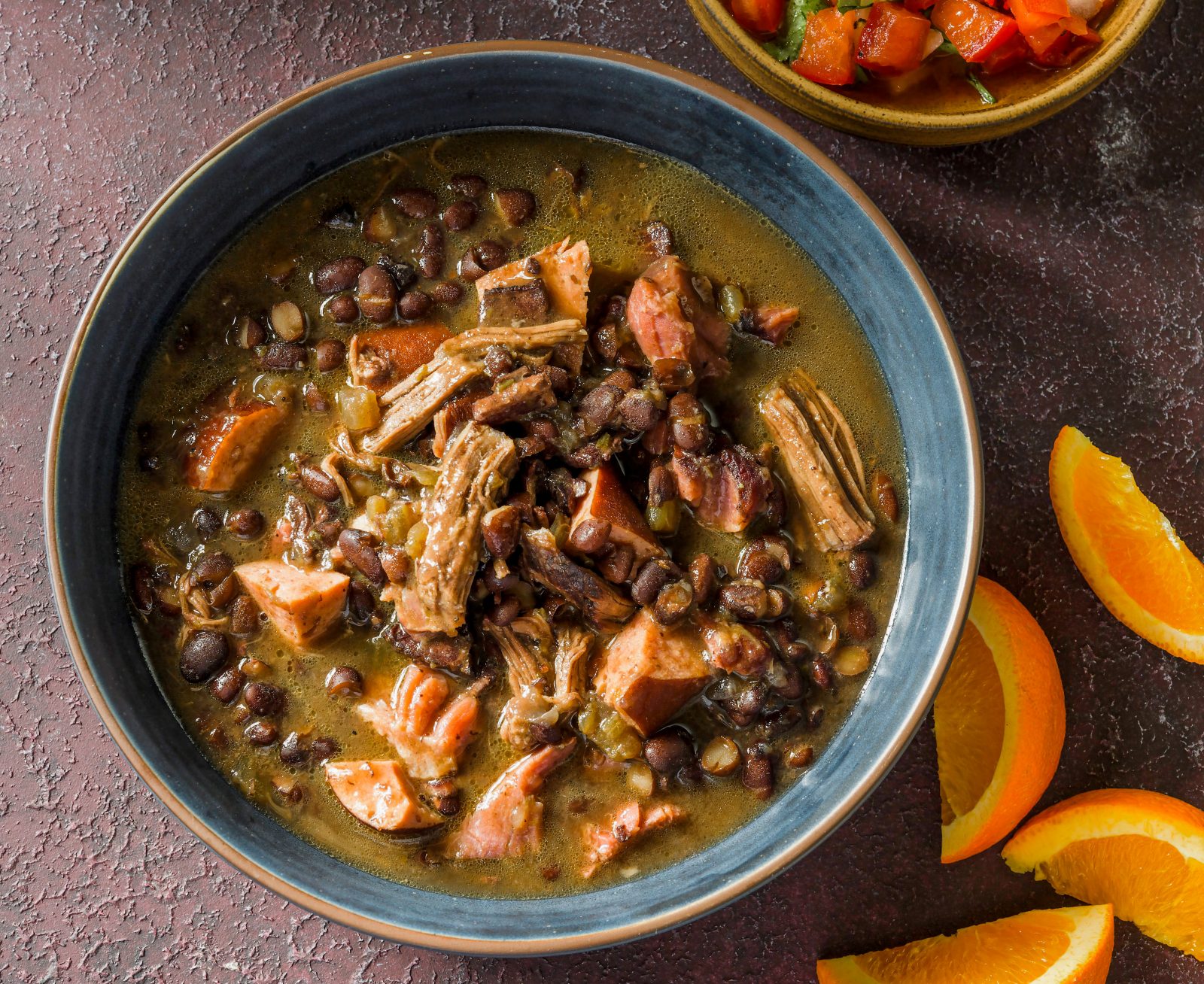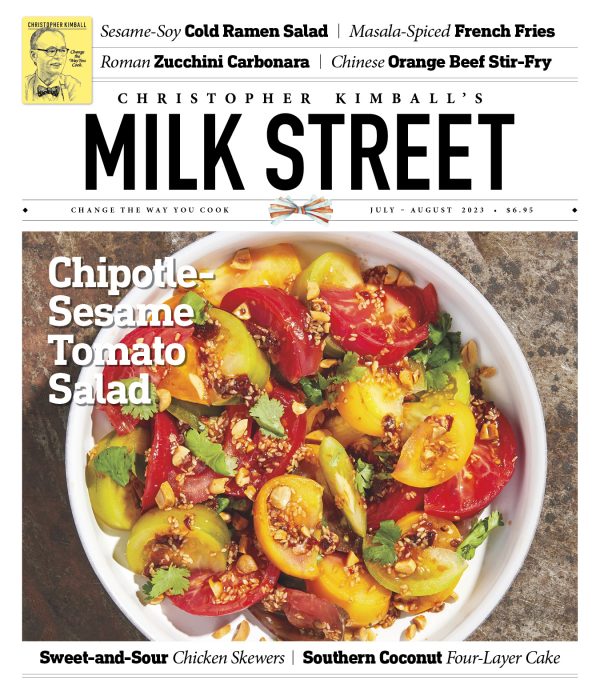Your email address is required to begin the subscription process. We will use it for customer service and other communications from Milk Street. You can unsubscribe from receiving our emails at any time.




Brazilian Black Bean Stew with Pork and Beef (Feijoada)
This recipe is free for a limited time. 12 WEEKS FOR $1 TO ACCESS EVERY MILK STREET RECIPE. Learn More.
During a visit to São Paulo, we learned that there are as many versions of Brazilian feijoada as there are cooks who make it, but one thing is constant: It is hearty, soulful fare. Feijoada can be an elaborate celebratory meal made with a dozen or more cuts of pork and beef, each removed from the pot and served individually, buffet-style, along with the stewed beans. It also can be a basic, workaday stew simply ladled into bowls. Ours is more like the latter: a streamlined serve-from-the-pot version, but with rich, slow-cooked flavor. We do, however, skip the hard-to-source meats, such as Brazilian beef jerky and smoked pork ribs, that are included in traditional feijoada. Instead, we use cuts that are easy to find at the supermarket, including bone-in beef short ribs and smoked ham hock, collagen-rich cuts that lend the broth flavor and body. The addition of cachaça, a Brazilian spirit distilled from sugar cane, is a unique touch from Francisco Gameleira, chef at A Figueira Rubaiyat restaurant in São Paulo. We also borrowed his idea to include a little orange juice; these liquids help lift the heftiness with a bit of bright sweetness. Feijoada is commonly served with orange slices or wedges along with “vinagrete,” a salsa-like mixture of chopped tomatoes, onion and herb—both bring welcome color and freshness. Serve the stew with rice and, for a typical Brazilian meal, with sautéed collard greens and farofa, or toasted cassava flour.
8 to 10
Servings
Don’t bother soaking the beans. Whereas most dried beans need to be soaked prior to cooking so they hydrate evenly and fully tenderize, black beans need only to be rinsed before they’re added to the pot. Also, don’t add any salt to the pot except with the aromatics. The bacon, ham hock and sausages are all well-seasoned cuts that lend salinity to the broth, so it’s best to wait to the end to see if additional salt is needed.
4¼ hours
40 minutes active
-
12
ounces thick-cut bacon, chopped
-
3
medium celery stalks, chopped
-
2
medium yellow onions, chopped, divided
-
8
medium garlic cloves, chopped
-
1
bunch cilantro, stems minced, leaves roughly chopped, reserved separately
-
3
bay leaves
-
1
teaspoon ground cumin
-
Kosher salt and ground black pepper
-
¼
cup cachaça (see headnote) or white rum
-
¼
cup orange juice, plus wedges to serve
-
1
pound dried black beans, rinsed
-
1¼
pounds bone-in beef short ribs
-
1
pound ham hock
-
1
pound linguiça or chorizo sausage links
-
1
pound ripe tomatoes, cored and chopped
-
01In a large Dutch oven over medium-high, cook the bacon, stirring occasionally, until lightly browned, 5 to 8 minutes. Add the celery, 1 onion, the garlic, cilantro stems, bay, cumin and ½ teaspoon pepper. Reduce to medium and cook, stirring often, until the vegetables are translucent, 10 to 15 minutes.
-
02Add the cachaça and orange juice; scrape up any browned bits. Stir in the beans and 3½ quarts water, then bring to a boil over high. Add the short ribs and ham hock; stir to combine. Reduce to medium-low and simmer, stirring occasionally, for 2 hours; skim off and discard any scum that rises to the surface during simmering.
-
03Add the linguiça and cook, uncovered and stirring occasionally, until the beans are fully tender and the meat from the short ribs and ham hock is falling off the bones, about 1½ hours.
-
04Meanwhile, in a medium bowl, stir together the tomatoes, the remaining 1 onion, the cilantro leaves and ½ teaspoon each salt and pepper. Cover and refrigerate until ready to use.
-
05When the beans and meats are done, remove the pot from the heat. Using tongs, transfer the short ribs, ham hock and sausages to a large plate; let cool slightly. Remove and discard the bay. Cut the sausages into pieces of the desired size and return them to the pot. Using your fingers, shred the meat from the ribs and hock into bite-size pieces, discarding the skin, bone and gristle; stir the meat into the pot. Taste and season with salt and pepper.
-
06Serve the feijoada with the tomato salsa and orange wedges alongside.
Hi Steve -
If you are using a computer, the PRINT icon (shaped like a black flag) will appear to the left of the ingredient list - it follows as you scroll. On a phone or iPad, you have to use the same method to print as you would for any website - click the square with the arrow in it at the bottom of your screen and then choose Print from the menu.
Best,
The Milk Street Team
Is there supposed to be that much fat in the dish? The fat from 12 oz. of bacon plus the fat from the short ribs was a lot. It was incredibly unctuous, but over the top. Please advise if you think I’ve done something wrong.
Hi AJ -
The fat from the bacon gets used to sauté the aromatics so there shouldn't be much of that leftover once those are softened. It's possible that your short ribs were much fattier than what we were using and may be dependent on how the butcher trimmed them. If you find that there is a thick layer of fat and muscle on the top, we would probably recommend removing that to reduce the amount of fat. Otherwise, any other remaining fat should be stirred in to make the dish emulsified and creamy.
Best,
The Milk Street Team
Will mexican chorizo work in this dish? The kind of chorizo I see in my grocery store meat case?
I am not familiar with Linguica sausage. Thx!
Hi Carol -
If you can't find Portuguese linguiça, which is smoked and fully-cooked, you can substitute with Spanish chorizo, which is similarly smoked, fully-cooked, and cured. Spanish chorizo is usually a little bit spicier than linguiça, but it can vary widely by brand. Mexican chorizo is always sold fresh and would need to be cooked. We don't recommend Mexican chorizo in this recipe.
Best,
The Milk Street Team
This dish is absolutely delicious! The complexity that's results from a fairly easy preparation is outsized. My only struggle was that it took a lot longer for the beans and meat to soften. After asking the Milk Street community on FB, however, I was given the suggestion to add a dash of baking soda, which solved the problem. I encourage everyone to try this dish. You will be happy you did!







I cannot see an icon to print the recipe I am currently looking at.